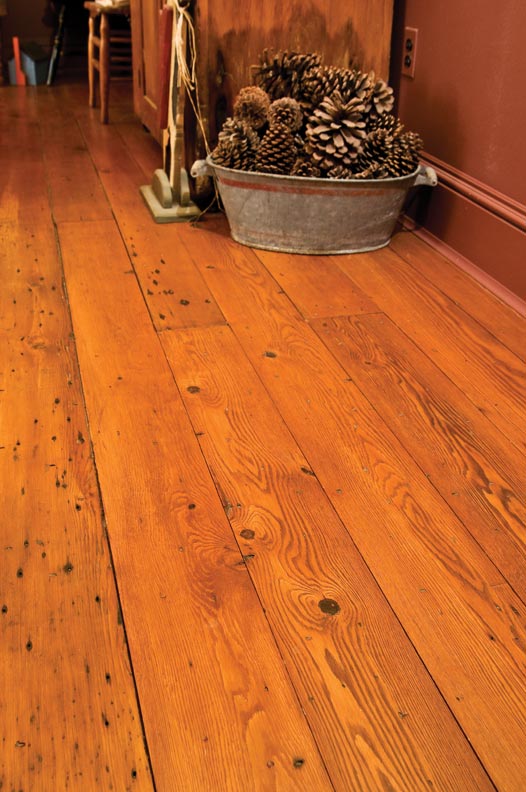The holes are the only way to tell originals from the laced-in boards here. (Photo: Andy Olenick)
Match an Existing Floor
It can be difficult to exactly match new floors to old; these methods will make the transition between the two less drastic and more pleasing to the eye.
1. Check reclaimed lumber suppliers, who may have old-growth species that match your original one. Keep in mind whether you need strip or plank boards, and the grade of your original floor.
2. When matching new flooring to old, make sure to purchase the new in the same profile. The new floor can be slightly thicker because it can be sanded to match the old floor—but it should never be thinner.
3. Consider lacing in the new boards. The process involves removing some planks of the original floor and integrating the new flooring, staggering the new boards into the old ones. It works especially well in wide openings, as above.
4. To match the color of the original floor, try making a custom mix by diluting the stain—but it can be tricky to get the color right. For the best results, both the original and the new floor should be sanded and refinished to match.
5. Install transition strips, also called T molding, which act as a bridge between floors that don’t match.
Remove White Rings
White rings form when water gets trapped in the floor’s finish. If the rings don’t disappear after drying (some do), here are three methods to try:
Iron
Place a clean cotton cloth such as an old T-shirt over the white ring. Then rub the stain with an iron—make sure it’s not set to steam!—for two or three seconds. Don’t press for too long, or you may damage the floor’s finish.
Steel Wool
Generously coat very fine steel wool (#000 or #0000) in lemon oil so that it won’t scratch the wood. (Lemon oil doesn’t remove the stain.) Gently buff the white ring with the steel wool until the stain is gone.
Denatured Alcohol
Dampen a clean cotton cloth with denatured alcohol, and gently rub the stain for two to three seconds.
Get Rid of Black Marks
Black marks are formed when water penetrates beyond the finish and into the wood. They are more difficult to remove, but it’s still doable.
Step 1
Sand the stained section of the floor to remove the finish.
Step 2
Brush bleach onto the black mark and let it dry. If needed, repeat. Allow the bleached area to dry overnight. Still stained? Try a commercial wood bleach.
Step 3
Once the stain is gone, neutralize the bleached area using a sponge and a mixture of two parts water and one part white vinegar.
Step 4
Refinish the floor to match the existing.
Fill In Gaps
When solid hardwoods develop gaps between boards, usually after decades of use, it’s easy to fill them in with this tried-and-true technique.
Step 1
Vacuum the gap to remove any debris.
Step 2
Choose the right filler: Wood putty can harden and crack, so use a flexible latex- or silicone-based filler for gaps that are less than 1/8″ wide in a color that matches your floor’s finish. (Larger gaps will require a different treatment, such as filling with rope, wood slivers, or commercially made products.)
Step 3
Cut the tube of filler at a slight angle to make application easier; these tubes fit into a standard caulk gun. Press the caulk gun trigger, and run a bead of filler along the length of the gap.
Step 4
Remove excess filler by running a plastic caulk trimmer along the seam.







